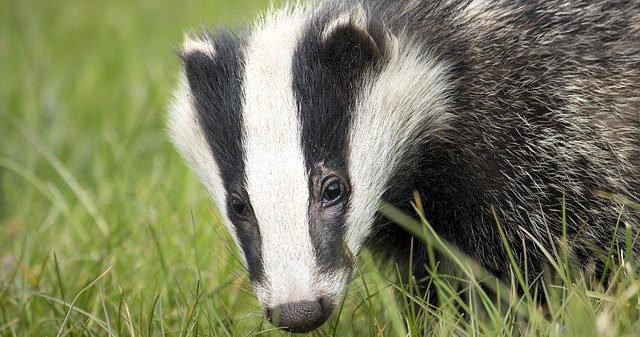Badgers have been a part of the UK’s eco-system for at least half a million years, some would argue more, so these animals are anything but visitors or unwanted guests. Yet, crimes against, and cruelty towards, badgers is still all too common in the United Kingdom. We say crimes, because that’s what they are, well ever since the badgers Protection Act was brought in, which we will describe in more detail later.
Despite this act being put in place to protect badgers, their lives are still being adversely affected by human behaviour, both intentionally and accidentally, and while badger numbers have increased since the implementation of the wildlife protection act in 1973, there are still too many of these majestic creatures being killed needlessly.
It is our intention with this article, to shed a little light on how badgers live, their diet, behaviours, and more, in the hope that it will help people to understand these animals more, and hopefully lead to better protection of the species.
Are badgers endangered in the UK?
Unlike hedgehogs and butterflies who are dying off very rapidly, badgers are not an endangered species and their numbers are actually quite healthy.
However, they do remain a protected species, and this because of a cruel practice known as badger baiting, where the badger’s homes (known as sets) are dug up and then dogs are used to torture the poor animals to death, with the dogs themselves often getting badly injured.
Despite this bloodsport being outlawed in the UK since 1835, it still goes on illegally and some groups who participate are actually really well organised and this is why the police need the help of the population to catch these criminals and help protect our badgers.
Badgers protection act
Badgers first found some protection in 1976 under the provisions of the wildlife act, and again with the wildlife and countryside act of 1981. A specific badger protection act was implemented in 1992, and this is aimed at preventing intentional cruelty at the hands of people badger baiting, the illegal capture of the animals, and upsetting the badgers while they are in their set, whether unintentionally or on purpose.
Sometimes, licenses are issued to people to destroy badger sets, usually if the sets are in an area that is undergoing development for housing or new roads, but this entails the use of experts to remove the badgers from the area and relocate them somewhere safe before work can continue.
There have also been times when certain regions have been permitted to cull badgers. This was due to a scare that the animals were spreading tuberculosis to cattle in those areas, but these were rare cases.
Badger’s appearance
If you are lucky enough to observe a badger in the wild, it shouldn’t be too hard to identify that it is a badger that you are looking at and not some other woodland mammal.
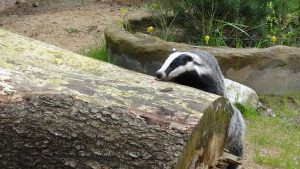
Badgers have a very distinctive appearance. First of all is their size; these animals can grow to around 90cm long, although the average is about 75cm, and weigh 10 to 12 kilograms.
They are short in height, but very powerfully built, particularly in the front legs and neck, and have grey fur covering their body and a small furry tail.
What really makes badgers distinctive though, are their striped black and white faces and small ears with white tips. The head is wider at the rear than the front giving a sort of pointed appearance.
Where do badgers live?
Badgers live in ‘sets’ which are underground burrows, or a series of connecting tunnels. The larger sets can be thought of as the badgers’ family home or headquarters, and are shared by multiple animals known as a clan. These large sets are lived in, developed, and expanded over generations, with some being up to 100 years old.
Then there are smaller ‘outliers’. These are usually smaller burrows with a single entrance rather than the multiple entrances and exits of the larger sets. These outliers are usually used as pit stops for the badgers to rest in while they are foraging in the warmer months of the year.
When it comes to housekeeping, badgers are no slackers, and will periodically remove and replace the materials they have been using for bedding to reduce the number of fleas and lice that they have to contend with.
Most main sets are found in woodland, although it is not unheard of that badgers will settle closer to urban areas if they can find a good place to burrow down and dig sets.
Do badgers live alone?
No, they are actually very social creatures and live in harmony with up to six other badgers. These groups are called clans, and they will happily share their territory with each other.
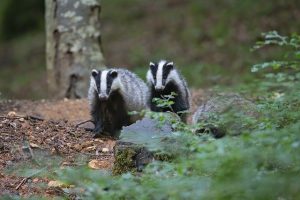 However, badgers from other clans are not so welcome, but to avoid unnecessary conflict, a clan’s territory is marked out by ‘latrines’ which are exactly what they sound like: dugout trenches filled with poo, or scat as it is more accurately called.
However, badgers from other clans are not so welcome, but to avoid unnecessary conflict, a clan’s territory is marked out by ‘latrines’ which are exactly what they sound like: dugout trenches filled with poo, or scat as it is more accurately called.
The scent of this scat lets other badger clans know that they are approaching another clans territory and so fights can be avoided.
Badgers use scent in a number of ways such as showing their mating status or warning other animals. They also use their scent glands to cement their relationships with the other badgers in their clan, with some studies claiming that badgers in a clan will even develop the same or similar scent.
Badger diet
Being omnivores, badgers will eat just about anything if they are hungry, but the vast majority of their diet is made up of earthworms. However, if there isn’t an abundance or worms around, these creatures won’t turn their nose up at slugs, snails, and other insects.
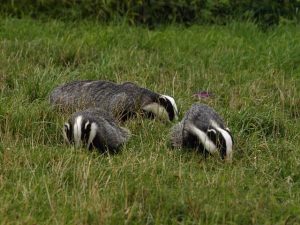
Badgers are the largest land predator in the UK, and as such will occasionally feast down on rodents, frogs, birds’ eggs ( a good reason to keep your bird table in the open), rabbits, and even hedgehogs. It has to be said though, that the frequency of badgers eating hedgehogs is often exaggerated, and they actually live in harmony for the most part.
Berries, seeds, fruit, nuts, and bulbs are also all known to be part of a badger’s diet.
Badgers- mating and breeding
Badgers will mate at any time of the year, but the peak times are usually February through May, and in the summer months, ending in September. Mating usually starts when badgers reach twelve to fifteen months old, although it may occur earlier for females (sows) or later for males (boars).
When a boar wants to mate he will walk around the set and stop at various entrance holes and start sniffing, trying to pick up on the scent of a receptive sow. When he thinks he’s found one, he’ll make a distinct noise and try to entice her out of the hole. If he is unsuccessful, he will then try again at another entrance.
Once the boar has found an interested sow, there then begins the actual mating ritual, which is kind of like a badger’s version of the kiss chase game we played as kids. The sow will run around in circles and the boar will follow, slowly and purposefully, for up to an hour and a half ( though this is quite a long example) until the ritual is finished. With the sow’s egg fertilised, you’d think that the baby badgers would be arriving very soon after, but this often isn’t the case.
Female badgers can go through a process that is known as delayed implantation, where a fertilised egg can be kept, suspended in the uterus for a very long time before the release of a certain hormone from the sow finally moves the egg to the womb. This means that a sow can continue to mate with several boars even while fertilised by others and will birth cubs from different fathers.
Badger cubs generally weigh eighty to a hundred and twenty grams at birth, and measure somewhere between twelve and fifteen centimetres long. Even at birth they display those distinctive black and white stripes on their faces. The cubs will remain underground until they are about twelve weeks old and then learn the important social aspects of being a badger from adult animals.
How can I observe badgers in the wild?
If you want to observe badgers in the wild, you have to be very careful not to disturb them or their habitat as this will get you in trouble with the law, plus it is not good for the badgers themselves.
A good way to do this is to find a badger set, then position yourself away from it at a distance and downwind to help hide your scent. The use of a good wildlife camera with infra-red night vision can be very handy as badgers are nocturnal and will usually only emerge at dusk.
Keep your distance and stay still, and you should get a great display of their natural behaviour. Badgers’ only predators are humans and so they will flee back into the safety of their set if they see, hear, or smell you.
How can I help badgers in the UK?
One of the best ways to help badgers in the UK is to report anyone you suspect of badger baiting, or being cruel to the animals otherwise. Also, keep an eye out for people developing land where badger sets are located and inform both the people digging up the land and the authorities. It might be that the developers of the area had no idea that badgers were there, and will probably be thankful that they didn’t accidentally break the law by continuing to dig there.
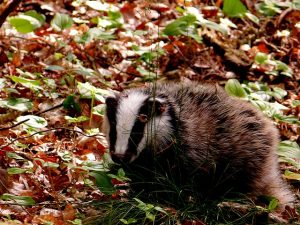
Another way to help badgers is to feed them occasionally. I say occasionally because you don’t want them to become dependent on you as a food source. However, leaving some food in an easy to reach space infrequently is just fine. The times when badgers need the most help foraging food is in hot dry periods because of the lack of worms, and also in the late Autumn.
Badgers don’t hibernate like hedgehogs, but they do spend a lot more time underground and less time foraging for food and rely on their body fat supplies to help them through this difficult time. Leaving food for them in Autumn is a good way to ensure they gain the necessary fat to see them through the winter.
Dried dog food, unsalted nuts, fruit, and mealworms (that you can also use to feed birds) are all good things to leave out for badgers to eat. Just leave it in a small pile (no more than a couple of handfuls) that is easy for them to reach and the badgers will do the rest.
Please be aware that badgers are known to dig up flower beds and lawns on occasion, so if you really value these things, it might be best leaving the food away from your property but in a space that you know the badgers frequent.
Quite a few badgers are either killed or badly injured on the UK’s roads, so if you are driving at night, especially near woodland, try to keep your speed down, your high beams on, and your attention on the road ahead.
If you slow to let a badger cross, wait a moment or two before accelerating and continuing, as badgers sometimes follow each other’s routes.
The RSPCA can be called on 0300 1234 999 if you encounter an injured badger, or if you are involved in an accident with one. Some people may be scared off by the laws protecting badgers and choose not to call for help, but if it was genuinely an accident, you have nothing to fear, and calling the number above could save that badger’s life.
The RSPCA can also be contacted if you see badger cubs near a road without an adult badger nearby. Don’t try to touch or grab the cub yourself as they will probably bite you out of fear and they can cause injury.
